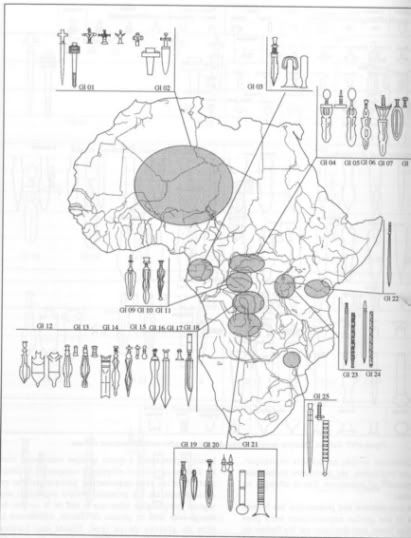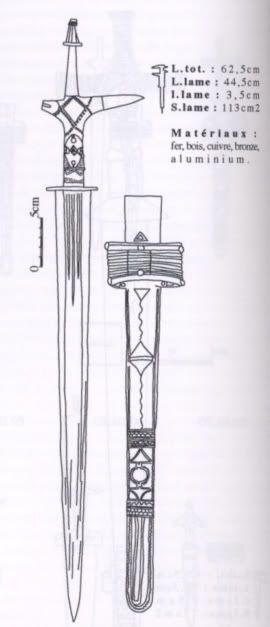
 |
|
|
#1 |
|
Member
Join Date: Aug 2006
Location: Belgium
Posts: 171
|
I have this dagger, don't know where it's from, first tought was something like Touareg. I think it's not very old but looks nice. The blade have some strange "stripes", the hilt is made from red & yellow copper, wood and alluminium? It is 29 cm long and the blade is about 4-5mm thick, any coment is welcome, thanks.
|
|
|

|
|
|
#2 |
|
Member
Join Date: Dec 2004
Location: What is still UK
Posts: 5,925
|
A nice dagger. Surely western Sahara. It looks pre ww2. I have always assumed that aluminium was only widely used after the ww1 as that is when production really took off. I now feel certain that this metal was in use much earlier, the last half of the 19th cent. Especially when one looks at quality pieces which I believe this knife represents. Some people might argue that the use of this metal reflects an art deco influence. I feel the use is more related to luxury, rather than chrome and futurism. Therefore from an earlier epoch. What a shame it is missing a scabbard. Not every piece with aluminium will be old I might add.
|
|
|

|
|
|
#3 |
|
Member
Join Date: Dec 2004
Location: What is still UK
Posts: 5,925
|
I also think, that although this dagger originates from north of the equator it is not North African. In my opinion it is from the southern part of the Sahara, the Sahel and quite old. The French were one of the first to promote the use of aluminium. The similarity with this Hausa hilt, the knobs in particular are too close to ignore, a wide spread phenomenon throughout this region.
|
|
|

|
|
|
#4 |
|
Member
Join Date: Jan 2006
Location: Kent
Posts: 2,658
|
Wow.....very nice dagger Congoblades.
 I have seen similar on eBay.....not as old as yours looks........but both were said to be Toureq. I think Tim might be onto something....many swords and knives from the North .....are described on eBay as Toureg.. I have seen similar on eBay.....not as old as yours looks........but both were said to be Toureq. I think Tim might be onto something....many swords and knives from the North .....are described on eBay as Toureg..  ..even when they are clearly Baja, Hausa etc ..even when they are clearly Baja, Hausa etc 
|
|
|

|
|
|
#5 |
|
Member
Join Date: Aug 2006
Location: Belgium
Posts: 171
|
Thanks Tim and Katana. Tim, the knobs are indeed close to your knive. I have not much experience with such kind of knives, I have one wich is a more typical Toeareg knive (a recent and toeristic one) and I see some resemblances to, not in the knobs but more in general, the way it is made. Indeed a shame missing the scabbard, maybe it would be more clear to see where it is from
 Greets, Guy |
|
|

|
|
|
#6 | |
|
Member
Join Date: Aug 2006
Location: Belgium
Posts: 171
|
Quote:

|
|
|
|

|
|
|
#7 |
|
Member
Join Date: Dec 2004
Location: What is still UK
Posts: 5,925
|
Hello Guy, have you got the book- Armes traditionnelles d'Afrique. {dagues,poignards,glaives,epees,tranchets et couperets} Approche regionale et classification technique, morphologique et esthetique. Tristan Arbousse Bastide. It is very good. It must be Toureg from the SW. I will post another knife latter. This could be a good thread.
|
|
|

|
|
|
#8 |
|
Member
Join Date: Aug 2006
Location: Belgium
Posts: 171
|
Hi Tim, I don't have the book, if you say it is very good I will look after it, saw it already on a quick google search, it is not expensive so I will manage the get it
 I will also post one more, little different but very nice, Toeareg knive later, it's not mine. |
|
|

|
|
|
#9 |
|
Member
Join Date: Dec 2004
Location: What is still UK
Posts: 5,925
|
An extract from the afore mentioned book showing the foot print of Toureg style daggers. As can be seen at the southern and south eastern edges many other groups of people would have to be included. It will be hard to sort the sub groups out.

|
|
|

|
|
|
#10 |
|
Member
Join Date: Jul 2005
Location: Toronto, Canada
Posts: 1,242
|
Hi,
There is one such dagger presently listed on eBay (I will post the link once it's finished) with a sheath very similar to that of some takuba. What's surprising is that these knives seem to be of high quality, they show fine craftsmanship, not like the cheap tourist trinkets. I wonder how old this style is...similar to the telek in some respects, but not quite a telek...I like it. The luxury, as Tim remarked, would indicate that it was made to be seen, not concealed like the telek. What's also striking is how similar the features of this knife are to the Tuareg jewellery...the same profusion of stacked geometric figures. Art deco is aptly put. Emanuel |
|
|

|
|
|
#11 | |
|
Member
Join Date: Jul 2005
Location: Toronto, Canada
Posts: 1,242
|
Here is a snipet from a thread in the old forum "Report from Agadez" that I think concerns these daggers:
Quote:
Emanuel |
|
|
|

|
|
|
#12 |
|
Member
Join Date: Aug 2006
Location: Belgium
Posts: 171
|
This is the other knife, it has simular decoration as the one above. This is mostly seen as a Foelbe knive (also known as Peul, Foelani, Felaata en Foela)?
But I still think this, and also the one obove, is more or less a touristic knife, well made but not for use, to blade is to weak for the real work 
|
|
|

|
|
|
#13 |
|
Member
Join Date: Dec 2004
Location: What is still UK
Posts: 5,925
|
Just because the blade is not obviously blood thirsty does not mean it is made for tourists. This knife is no way a tourist piece. The blade is quite flexible and not immediately aggressive, given the light clothing worn in desert regions, I would take great pains to avoid being stab but such a weapon even if it has a large element of showiness.
The picture from "Waffen aus Zentral-Afrika" suggests Bornu which I favour, over the illustration from "Armes traditionnelles d'Afrique" Toureg origin. The latter book having illustrations of a great many other styles all attributed to Toureg. I think this is any area where a lot of research is yet to be done.    
|
|
|

|
|
|
#14 |
|
Member
Join Date: Aug 2006
Location: Belgium
Posts: 171
|
Tim, the examples you gave are indeed nice weapons, you can clearly see they are forged, the two I posted are not. I think that makes a difference.
|
|
|

|
|
|
#15 |
|
Member
Join Date: Aug 2006
Location: Belgium
Posts: 171
|
One more Foelbe knife, same model but with a well forged blade and older. I have seen some more nicly made but with a poor blade cut of a plate of iron.
|
|
|

|
|
|
#16 | |
|
Member
Join Date: Jan 2006
Location: Kent
Posts: 2,658
|
Quote:
Hi Congoblades, many functional knives can be produced by 'stock removal', many modern African blades are made from car 'leaf springs' ....a good source of carbon steel. This is then ground/ filed into shape......if a mechanical grinder is used ...you have to be careful not to overheat the steel (through heat build-up from the grinding process) otherwise the 'temper' of the steel is altered and 'softens' the steel. Many newer Takouba's have thin flexable blades ....which do not appear to be 'forged' ....and the fullers are 'ground' as well....but can be quite sharp. They could certainly wound an opponent who is wearing 'traditional' light clothing....as Tim has already pointed out..... I have a old Hausa arm dagger, which has a very nicely tempered blade, thin with some "springy-ness", definately a 'user'.... |
|
|
|

|
 |
|
|